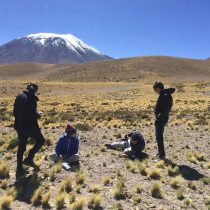
The desert potato (Hoffmannseggia doelli) is undoubtedly a unique plant. It grows in extreme conditions, in full sun in the desert, under strong exposure to radiation and at high altitude. In this area the rainfall is escazas reaching only between 100 to 300 mm annually and there is also a high temperature fluctuation, with 40 ° C in the day and -8 ° C during the night. This plant generates a small tuber, which is an attractive alternative as food in the current climate change scenario.
Thinking about the advance of desertification towards the center of the country and the need to generate new crops that resist these conditions, was the motivation of the researcher Viviana Araus, of the Millennium Institute of Integrative Biology (iBio), to develop an ambitious project that aims to establish the desert potato as a new crop capable of growing in marginal soils.
It will be four years of work with this plant. Although the desert potato has not been cultivated, there are records that it was collected and consumed by the ancient locals and shepherds who roamed this area of the Atacama Desert. Rodrigo Gutiérrez, principal coordinator of the project, academic at the Pontificia Universidad Católica de Chile and Deputy Editor of iBio, has studied for more than 10 years different plants that grow in the desert, including Hoffmannseggia doelli. Among the most notable results, Gutiérrez’s team has revealed that the desert potato has a great nutritional value, being rich in potassium, fiber, iron and magnesium.
Food of native peoples
“This plant forms in its roots tubers that in ancient times were the food of native peoples. It also stands out because it grows in soils with low availability of nitrogen, which is a key nutrient,” Araus said.
This potato was marginalized from industrialized agriculture. It is small, irregular and has never been cultivated massively, being surpassed by other much more profitable potatoes. But its unique features again make it in the eyes of experts. In addition, given the current challenges of new marginal conditions due to climate change facing agriculture, the desert potato is presented as an option of high nutritional value, of an endemic nature and as an alternative to traditional crops that in future climatic conditions will not be able to be developed.
Dav
To try to position this plant as a crop, Araus, from iBio, explains that they will standardize a culture and management protocol in conditions of drought and low nitrogen availability, and transfer all the knowledge to the Farmers’ Association of Socaire, in northern Chile. It also contemplates the design of a strategy for marketing desert potato products in the national market to support farmers.
Among the potentials highlighted by those in charge of the project, the opportunity to include farmers in the optimization of the protocol stands out, by carrying out the field tests in direct collaboration with farmers in the northern part of the country.
“We will give them the protocols to carry out the desert potato cultivation tests and we will receive their observations of the process, taking into consideration the peasant knowledge and the construction of joint knowledge with the technical team of the project. Finally we hope to finish the project having a sustainable product in time that allows the commercialization of this potato”, concludes Araus.





